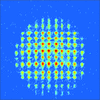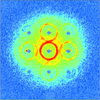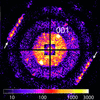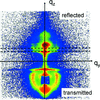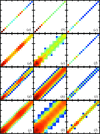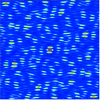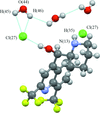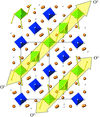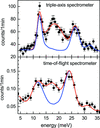issue contents
August 2014 issue

Cover illustration: Scattering data from an opal sample measured using nine beams on D33 at the Institut Laue–Langevin, showing clearly the first-order Debye–Scherer Bragg ring at |q| = 3.76 × 10−3 Å−1 as well as higher-order diffraction rings. Courtesy of Dewhurst [J. Appl. Cryst. (2014), 47, 1180–1189].
scientific commentaries
Free 

Some recent developments in neutron scattering instrumentation are discussed.
feature articles
Mode analysis and comparison of reported different phases of lead zirconate titanate was carried out. Most of the structural models comply with expected single three-dimensional order parameter correlations.
research papers
Novel multiple-beam very small angle neutron scattering (VSANS) using a conventional SANS instrument
A novel technique is described to produce multiple neutron beams, which focus at the sample, and allow very small angle neutron scattering (VSANS) measurements to be made using a conventional small-angle neutron scattering (SANS) instrument. This extends the range of material length scales able to be studied to greater than 1 µm (and scattering vectors down to 10−4 Å−1), almost one order of magnitude greater than that of a conventional SANS instrument.
Open  access
access
 access
accessForm factors for X-ray scattering calculations from coarse-grained MARTINI protein models are derived. The reliability at different levels of coarse-graining is evaluated and weighed against the gain in computational speed of the coarser models.
Analysis of the Bragg rod intensity fluctuations present in the coherent X-ray scattering data from a 4 µm single colloidal crystal grain reveals the presence of a double hexagonal close-packed stacking sequence.
Open  access
access
 access
accessVolcanic cristobalite commonly contains structural substitutions of Al3+ and Na+ for Si4+. Quantifying the effect of these substitutions on the crystal structure may provide insight into volcanic processes and the variable toxicity of crystalline silica.
The second derivative of the isotropic correlation function of the regular octahedron has an algebraic form, which is reported.
The combination of both time-of-flight mode and grazing-incidence small-angle neutron scattering (GISANS) enables the simultaneous performance of several GISANS measurements that differ in wavelength. As a consequence, within one measurement a full set of GISANS patterns related to different scattering vectors, different scattering depths and different resolutions results, which allows the detection of the complex morphology of a defect-rich diblock copolymer film.
The Bio-SANS small-angle neutron scattering instrument at the High Flux Isotope Reactor of Oak Ridge National Laboratory and its performance are presented, along with unique sample environments.
The analytic expression is derived for a small-angle neutron scattering instrument that uses a focusing reflective optic.
A new experimental setup for high-throughput controlled non-photochemical laser-induced nucleation has been designed. The nucleation efficiency of glycine, as a function of the supersaturation of the solution used and the laser beam energy density, has been established for a large number of samples.
The transformation rate of austenite orientations has been investigated by means of electron backscatter diffraction measurements on a pre-defined zone of a quenched and partitioned steel during interrupted tensile tests. The modelled transformation potential, based on the phenomenological theory of martensite crystallography and the mechanical driving force, was found to match the experimental transformation rates in a close correspondence.
Open  access
access
 access
accessSome characteristics are reported of a triple-crystal diffractometer with a (+, −, +) setting of Si(220) using mirage diffraction. The advantages of this diffractometer are that its setup is easy, its structure is simple, the divergence angle from the second crystal is small and the energy resolution of the third crystal is very high.
It is difficult to estimate statistical uncertainties from powder diffraction data collected on two-dimensional detectors. Here, different approaches are compared and best practices suggested if the full variance–covariance matrix can be propagated, as well as the best approximate approach when only the variances are propagated.
Thermoreversible self-assembled fibrillar networks have been investigated using small-angle X-ray scattering, X-ray diffraction, differential scanning calorimetry, Fourier transform IR spectroscopy and scanning electron microscopy. It was found that the scope of gelation and gelation temperature are dependent on the nature of the alkyl side group, and the fibers showed a regular hexagonal arrangement during assembly.
A noncoplanar measurement geometry, achieved by using a diffractometer equipped with a detector arm possessing two degrees of freedom, is a promising technique for the analysis of residual stress gradients in polycrystalline objects and for anisotropic microstructure investigations.
The broadening of rocking curves may still be used to study high-quality samples employed for X-ray optics applications. However, this method has to be extended to its limits.
Computational X-ray cross-correlation results from two-dimensional model structures are presented in order to demonstrate how to extract the orientational local order of disordered samples. Special attention is paid to proper ensemble averaging and accounting for experimental influences such as detector noise and wavefront distortions.
After poling and reduction, single crystals of Rh-doped potassium niobate exhibit interesting structural and physical properties as examined by various characterization techniques. High-resolution X-ray diffraction studies reveal interesting microstructural changes, while Raman scattering, dielectric and photoluminescence studies show excellent correlation with respect to the changes in crystalline perfection.
Open  access
access
 access
accessAll-diamond optical assemblies holding state-of-the-art type IIa diamond crystals enable the construction of a beam-multiplexing X-ray double-crystal monochromator for hard X-ray free-electron lasers. Details on the design, fabrication and X-ray diffraction characterization of the assemblies are reported.
Diffraction experiments on a time-of-flight neutron strain scanner allow for nondestructive measurement of bulk texture within metallic components with ∼1 mm spatial resolution.
A remote-controlled microfluidic device for protein solution concentration and buffer exchange, simultaneous with small-angle X-ray scattering and ultraviolet absorption measurements, is presented.
Spin-echo small-angle neutron scattering is used to measure the average density of a charge-stabilized colloidal silica suspension confined in an array of channels whose width is a few times the particle diameter. The particle density in the channels is almost twice that in the neighboring colloidal fluid and is consistent with the particles organizing in close-packed sheets parallel to the channel walls.
Rietveld analyses of X-ray data were used to study the atomic arrangements in the hexagonal and orthorhombic martensites of the Ti–Nb system.
Download citation


Download citation


The crystal structure of hydrated (±)-mefloquine hydrochloride is determined by an ab initio algorithm (simulated annealing) using X-ray powder diffraction data and confirmed by a combination of theoretical calculations and Fourier transform–infrared spectroscopy.
CCDC reference: 952239
Resonant X-ray magnetic scattering has revealed the site-specific magnetic moments at two non-equivalent Fe ion sites in Fe3O4.
Download citation


Download citation


This article presents a new microcrystalline Sr11Mo4O23 material with a strongly defective structure resulting from oxygen vacancies and broken corner-sharing connectivity in the octahedral framework. The ionic conductivity is considerably activated after the reversible process of removal/uptake of O atoms.
CCDC reference: 1007689
A polycrystalline commercially pure sample of titanium has been measured using near-field and far-field three-dimensional X-ray diffraction techniques. The indexing results obtained with two different software packages (DCT and ImageD11) are compared.
In situ neutron and synchrotron measurements (small and wide angle) at high temperatures are accelarating Co–Re alloy development by providing an in depth understanding of the microstructural evolution in these alloys at such temperatures. In addition, advances in analytical tools in electron microscopy have enabled precise determination of the structure and composition of phases in Co–Re alloys.
cryocrystallography papers
This article highlights routine methods and the benefits of collecting cryogenic macromolecular neutron diffraction data.
teaching and education
Free 

Simple and efficient techniques are suggested to overcome problems that frequently arise when growing single crystals from solution.
short communications
Download citation


Download citation


Five crystals whose compositions represent typical small molecules refined to low R values despite being only partially bathed by the X-ray beam, the refinement differing little for the large crystal compared with that for a small crystal. Intensity measurements of crystals that are larger than the beam can be regarded as being satisfactory for light-atom structures whose intensities have been corrected by multi-scan methods; however, the measurements are better corrected by numerical methods, particularly for heavy-atom structures.
The algebraic expressions of the correlation functions of the regular tetrahedron and octahedron are presented.
The polarization coefficient is determined with a two-dimensional area detector via a cosine interpolation of the azimuthal dependence of the intensity variation at a constant diffraction angle.
computer programs
A program is presented for the calculation and visualization of distributed atomic polarizabilities, quantities which are useful for the evaluation of crystal properties such as the optical indicatrix.
Open  access
access
 access
accessA Python/C++ library for reading image data and experimental geometry for X-ray diffraction experiments from arbitrary data sources is presented.
A novel computer program, EBSDL, has been successfully developed to determine the unknown Bravais lattice of a bulk crystalline material using a single electron backscatter diffraction (EBSD) pattern. Unlike the phase identification technique in conventional EBSD applications, the new technique is completely independent of chemical information.
An update for BayesApp, a web site for analysis of small-angle scattering data, is presented. Most importantly the indirect transformation of data now includes an option for a maximum-entropy constraint in addition to the conventional smoothness constraint. A correction for slit smearing is possible, and options for calculation of the scattering intensity from simple models as well as estimation of structure factors for nonspherical objects have also been added.
laboratory notes
A new type of artifact is described, which was observed in a wide variety of inelastic neutron scattering spectra and which could easily be mistaken for a signature of real excitations.
addenda and errata
Free 

Ambiguities in the article by Andrews & Bernstein [J. Appl. Cryst. (2014), 47, 346–359] are clarified.
Open  access
access
 access
access

 journal menu
journal menu








